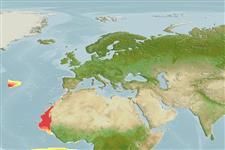Teleostei (teleosts) >
Syngnathiformes (Pipefishes and seahorses) >
Syngnathidae (Pipefishes and seahorses) > Syngnathinae
Etymology: Cosmocampus: Greek, kosmos = order, organization + Greek, kampe = bent, curvature (Ref. 45335).
Environment: milieu / climate zone / depth range / distribution range
Ecology
Marine; pelagic-oceanic; oceanodromous (Ref. 51243); depth range 0 - 79 m (Ref. 4509). Tropical
Eastern Atlantic: off south Morocco to Gambia (24°35'30"N, 13°31'N).
Size / Weight / Age
Maturity: Lm ? range ? - ? cm
Max length : 5.2 cm SL male/unsexed; (Ref. 4509)
Adults inhabit oceanic and coastal waters. Known only from pelagic sub-adults taken in stramin nets or midwater trawls (Ref. 4509). Ovoviviparous (Ref. 205). The male carries the eggs in a brood pouch which is found under the tail (Ref. 205).
Life cycle and mating behavior
Maturity | Reproduction | Spawning | Eggs | Fecundity | Larvae
Male carries the eggs in a brood pouch (Ref. 205).
Dawson, C.E., 1990. Syngnathidae. p. 658-664. In J.C. Quero, J.C. Hureau, C. Karrer, A. Post and L. Saldanha (eds.) Check-list of the fishes of the eastern tropical Atlantic (CLOFETA). JNICT, Lisbon; SEI, Paris; and UNESCO, Paris. Vol. 2. (Ref. 4509)
IUCN Red List Status (Ref. 130435: Version 2024-1)
Threat to humans
Harmless
Human uses
Fisheries: bycatch
Tools
Special reports
Download XML
Internet sources
Estimates based on models
Preferred temperature (Ref.
123201): 18.2 - 22.1, mean 20 °C (based on 36 cells).
Phylogenetic diversity index (Ref.
82804): PD
50 = 0.5000 [Uniqueness, from 0.5 = low to 2.0 = high].
Bayesian length-weight: a=0.00037 (0.00016 - 0.00085), b=3.18 (2.99 - 3.37), in cm total length, based on LWR estimates for this (Sub)family-body shape (Ref.
93245).
Trophic level (Ref.
69278): 3.2 ±0.5 se; based on size and trophs of closest relatives
Resilience (Ref.
120179): High, minimum population doubling time less than 15 months (Preliminary K or Fecundity.).
Fishing Vulnerability (Ref.
59153): Low vulnerability (10 of 100).
